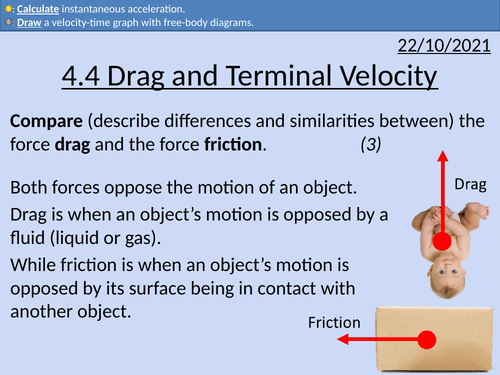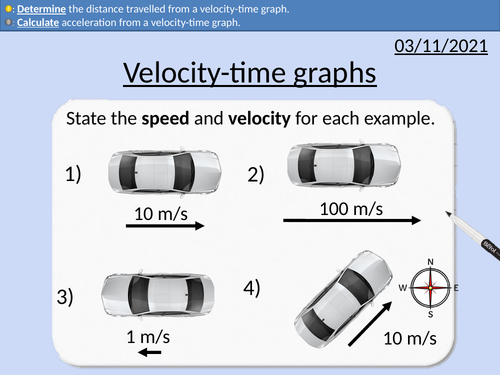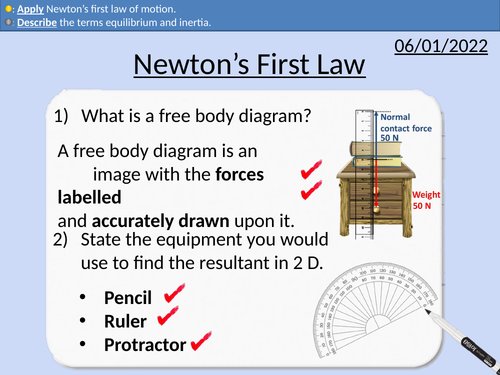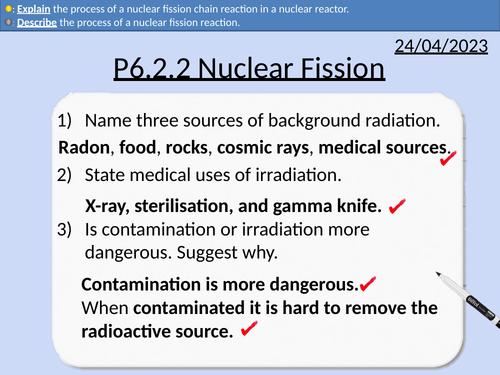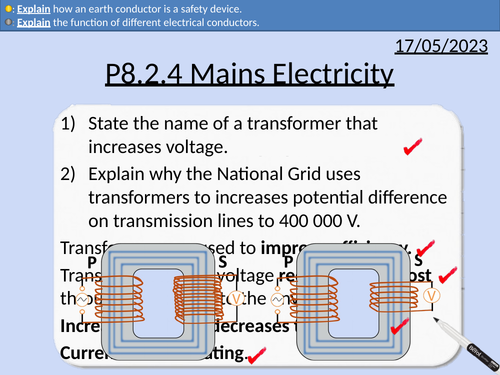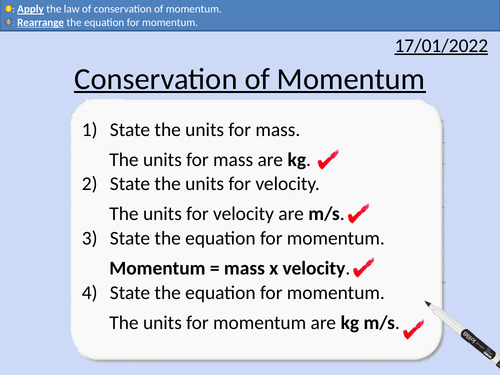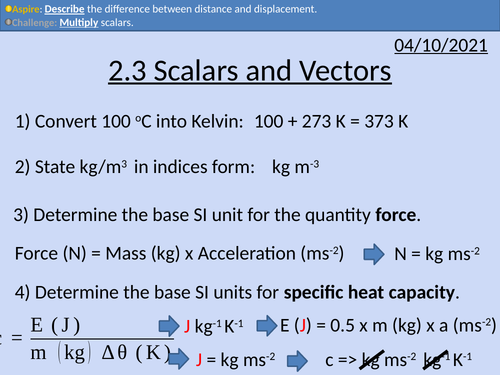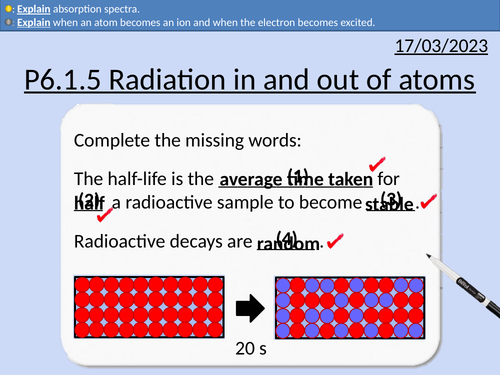454Uploads
139k+Views
62k+Downloads
Physics
Bundle

GCSE OCR Physics: P7.1 Energy and Forces
All resources for P7.1 Work Done GCSE OCR Physics Gateway 9-1. Triple and combined (Higher and Foundation) is covered in this material.
Energy Stores and Energy Transfers
Work Done and Kinetic Energy
Work Done, Kinetic Energy and Thermal Energy
Work Done and Spring Energy
Gravitational Energy
Kinetic Energy
Kinetic and Gravitational Energy
Gravitational and Spring Energy
Gravitational Force and Energy

OCR AS level Physics: Drag and Terminal Velocity
OCR AS level Physics: Drag and Terminal Velocity is a part of the Module 3: Forces and Motion
Presentation come with worked examples, solutions and homeworks.
Drag and speed relationship
Free body diagrams
Net forces and acceleration

GCSE Physics: Forces and Fleming's Left Hand Rule
This presentation covers OCR Gateway Physics 9-1 P4.2.1 Forces, Current and Fleming’s Left Hand Rule.
This presentation includes:
Interacting Magnetic Field Lines
Increasing Magnitude of the force on a current carrying conductor
Applying Fleming’s Left Hand Rule

GCSE Physics: Atmospheric Pressure
This presentation covers OCR Gateway Physics 9-1 P1.3.3 Atmospheric Pressure
This presentation includes:
Balanced and unbalanced forces
Resultant force
Changing atmospheric pressure
Exam style question with mark scheme

GCSE Physics: Distance, Time and Speed
This presentation covers material for OCR Physics Gateway 9-1 P2.1.1
Covered:
Measuring and calculating
Accuracy of stop watch vs light gate
Conversion of units
Exam style question
Worked examples
Students questions with answers
Bundle

GCSE OCR Physics: P1 Matter Full scheme
All resources for P1 GCSE OCR Physics Gateway 9-1.Triple and combined (Higher and Foundation) is covered in this material.
Includes:
End of topic test
Scheme of work
Development of the atomic model
Density
Temperature
Specific Latent Heat
Specific Heat Capacity
Pressure and Temperature
Pressure and Area
Pressure are Volume
Atmospheric Pressure
Liquid Pressure
Sinking and Floating
Bundle

GCSE OCR Physics P5 Waves
Resources for P5 GCSE OCR Physics Gateway 9-1 Triple and Combined (Higher and Foundation) is covered in this material.
Each lesson includes student activities and full worked answers.
Definition of a wave
Mechanical waves
Electromagnetic waves
Transverse waves
Longitudinal waves
Amplitude
Wavelength
Frequency
Time period
Calculating frequency and equation
Relationship between frequency and wavelength when speed is constant.
Calculating time period from frequency with equations
The speed equation
Measuring distance and time
Simple experiment for the speed of sound
Improving experiments
Echoes
Speed of sound experiment with microphones and oscilloscope.
Ray diagrams
Absorption, reflection and transmission
Sonar
Ultrasound
Rearranging equation
Refraction
Relationship between wave speed and wavelength
Structure of the ear.
Frequency range of human hearing.
Explanation of the limited frequency range of humans.
Explanation for hearing deteriorating with age.
Order of the electromagnetic spectrum
Wavelength and frequency relationship
Application of wave speed equation
Rearranging equation
Producing and detecting radio waves
Recall that light is an electromagnetic wave
Give examples of some practical uses of electromagnetic waves in the radio, micro-wave, infra-red, visible, ultraviolet, X-ray and gamma-ray regions
Describe how ultra-violet waves, X-rays and gamma rays can have hazardous effects, notably on human bodily tissues.
Explain that electromagnetic waves transfer energy from source to absorber to include examples from a range of electromagnetic waves
Precautions for ultra-violet waves, X-rays and gamma rays
Careers: Medical Physicist
X-rays
CT scans
Gamma imaging
Thermogram
Magnetic Resonance Imaging
Precautions for using ionising radiation
Law of reflection
Labeling and measuring angles of incidence and reflection
Practical activity instructions - fully animated.
Reflection, absorption, and refraction is affected by wavelength of electromagnetic wave.
Refraction the change of velocity - speed and direction
Magnitude of refraction depending on wavelength
Magnitude of refraction depending on optical density
Refraction practical activity instructions
Wave speed, wavelength, and frequency relationship in refraction
Convex and Concaves lenses
Eyes and corrective lenses
Refraction and wavelength
Focal points for lenses
Determining the type of images produced through a lens
Names of colours for the visible spectrum
Coloured filters
Coloured objects acting as a coloured filters
White light and refracting prism
Refraction and wavelength
Specular reflection
Diffuse scattering
Scattering - Why the sky is blue and milk is white.
Bundle

GCSE OCR Physics: P7.2 Power and Efficiency
All resources for P7.2 P7.2 Power and Efficiency GCSE OCR Physics Gateway 9-1. Triple and combined (Higher and Foundation) is covered in this material.
All powerpoints include student activities and worked examples.
Electrical Work Done
Paying for Electricity
Electrical Energy Transfers
Electrical Heating
Thermal Conductivity
Efficiency and Sankey Diagrams
Bundle

GCSE OCR Physics: P8 Global Challenges
All resources for P8 Global Challenges GCSE OCR Physics Gateway 9-1. Triple and combined (Higher and Foundation) is covered in this material.
Average speeds of walking, running, cycling, cars, trains, wind, sound, and light.
The speed equation
The acceleration equation
Explaining average speed camera
Explaining instantaneous speed camera
Estimating everyday accelerations
Calculating speed from rotation speed and circumference of wheels
Converting from miles per hour to meters per second
Reaction time definition
Factors that increase reaction time
Simple reaction time experiment
Thinking distance
Rearranging equations
Speed equation
(Final velocity)2 – (Initial velocity)2 = 2 x Acceleration x Distance
v2 – u2 = 2 a s
Factors affecting braking distance
Total stopping distances
Calculating area of a velocity-time graph for displacement (distance traveled).
Rearranging equations
MOT testing
Large accelerations produce large forces.
Values of g that cause severe injury or death
Road Safety
Newton’s First Law and seat belts
Crumple zones
Force = Mass x Acceleration
Acceleration = Change in velocity /Time taken
Estimating speed, accelerations and forces involved in large accelerations for everyday road transport.
Types of different energy sources
Renewable and non-renewable definitions
Different uses of energy sources - transport, heating, and generating electricity
Advantages and disadvantages of different energy sources
Fossil fuels – oil, coal, and natural gas.
Nuclear fuel – Uranium
Biofuels – wood, biodiesel, and biogas.
The sun - solar (PV) panels and solar heating panels
Tides
Waves
Hydroelectricity
Wind
Geothermal
How use of energy resources have changed over time. (Biofuels, Fossil Fuels, Nuclear, Renewable).
How energy use has increased (increase population and development of technology)
Explain patterns and trends in the use of energy resources.
Fossil fuels are finite and will run out at current consumption levels.
Structure of the National Grid
Step-up and Step-down transformers
How transformers increase the efficiency of the National Grid
Number of turns and potential difference
Current and potential difference in primary and secondary coils
Domestic Electrical Supply being 230 V, AC at 50 Hz.
Direct potential difference and alternating potential difference.
Reasons for insulation on wires.
Potential Difference between different conductors.
Function of the earth conductor.
Double insulation and no earth wire.
Reasons the live wire is dangerous.
Reasons why live to earth is dangerous.
Key facts about the Big-Bang model
Cosmic Microwave Background (CMB, CMBR)
Doppler Red shift of light from stars in galaxies
Hubble’s evidence of absorption spectra being red shifted
Structure of the solar system
Nuclear Fusion
Evolution of large stars
Evolution of Sun like stars
Gravitational force and force from nuclear fusion
Natural Satellites
Geostationary Satellites
Low Polar Orbit Satellites
Speed is constant and velocity is changing in stable orbits.
Changing speed and radius
Gravitational force, acceleration, and speed.
Plotting data and describing relationships
All objects emit electromagnetic radiation
Describe how changing temperature changes frequency, wavelength, and intensity of the radiation produced.
Explain why objects change temperature by absorbing and emitting radiation.
Explain why the temperature of the Earth changes due to greenhouse gases in the atmosphere.
S and P waves
Structure of the Earth
Reflection, absorption, and refraction of waves
Sonar to map the ocean floor

GCSE Physics: Graphs of Current and Potential Difference (I-V)
This presentation covers OCR Gateway Physics 9-1 P3.2.4 Graphs of potential difference (p.d.) and current.
Linear circuit element
Non-linear circuit element
Diodes and Light emitting diode (LED)
Current against potential difference graphs
How the gradient of a current against potential difference graph relates to resistance
Experimental set-up for determining circuit elements
How temperature affects resistance in lamps and metal conductors (wires)

GCSE Physics: Acceleration
This presentation covers OCR Gateway Physics 9-1 P1.2.3.
Content covered:
Definition for acceleration
Worked solutions
Students problems with answers
Exam style question with mark scheme

GCSE Physics: Velocity-time graphs
This presentation covers OCR Gateway Physics 9-1 P2.1.5
Analysing velocity-time graphs
Calculating the gradient
Acceleration from velocity-time graphs
Distance travelled from velocity-time graphs
Worked problems and solutions

GCSE Physics: Newton's First Law
This presentation covers OCR Gateway Physics 9-1 P2.2.3.
PowerPoint with multiple student activities and complete worked answers.
Newton’s First Law definition
Balanced and unbalanced forces producing accelerations
Acceleration being the change in velocity
The principle of inertia
Definition for equilibrium

GCSE Physics: Momentum
This presentation covers OCR Gateway Physics 9-1 P2.2.6
Momentum Equation
Rearranging the momentum equation
Momentum as a vector
Vector addition with momentum
Exam question with worked solutions
Student problems with answers
Proportionalities

GCSE Physics: Nuclear Fission
This presentation covers OCR Gateway Physics 9-1 P6.2.2 Nuclear Fission
This PowerPoint is a whole lessons included with student activities and animated answers.
Conservation of mass
Uranium as a nuclear fission fuel
Nuclear fission process
Chain reactions in nuclear fission reactions
Control rods and moderators in nuclear reactors
Benefits and disadvantages of nuclear fission reactors.
Mass-Energy Equivalence

GCSE Physics: The National Grid
This presentation covers OCR Gateway Physics 9-1 P8.2.3 The National Grid
This PowerPoint is a whole lessons included with student activities and animated answers.
Structure of the National Grid
Step-up and Step-down transformers
How transformers increase the efficiency of the National Grid
Number of turns and potential difference
Current and potential difference in primary and secondary coils

GCSE Physics: Mains Electricity
This presentation covers OCR Gateway Physics 9-1 P8.2.4 Mains Electricity
This PowerPoint is a whole lessons included with student activities and animated answers.
Domestic Electrical Supply being 230 V, AC at 50 Hz.
Direct potential difference and alternating potential difference.
Reasons for insulation on wires.
Potential Difference between different conductors.
Function of the earth conductor.
Double insulation and no earth wire.
Reasons the live wire is dangerous.
Reasons why live to earth is dangerous.

GCSE Physics: Conservation of Momentum
This PowerPoint presentation with worked examples and student questions covers:
Definition for conservation of momentum
Rearranging the momentum equation
Adding vectors (momentum)
Applying conservation of momentum
Elastic and inelastic collision
CERN and discovering particles with conservation of momentum

OCR AS level Physics: Scalars and Vectors
OCR AS level Physics: Scalar and Vector Quantities is a part of the Module 2: Foundations of Physics
Full lesson PowerPoint with worked examples and homework with complete worked answers.
Definition of scalars and vectors
Adding quantities with the same units
Determining if a quantity is a vector or scalar from an equation
Comparing displacement and distance

GCSE Physics: Absorption and Emission Spectra
This presentation covers OCR Gateway Physics 9-1 P6.1.5 Radiation in and out of atoms.
This PowerPoint is a whole lessons included with student activities and animated answers.
Arrangements of electrons and distance from the nucleus
Electron energy levels
Absorbing electromagnetic radiation
Electromagnetic radiation and energy
Absorption spectra
Emission spectra
Discovery of helium


